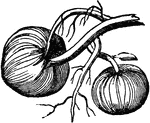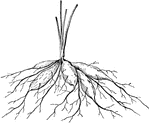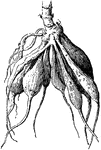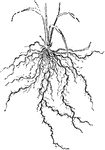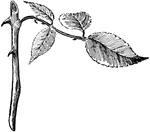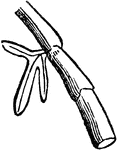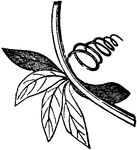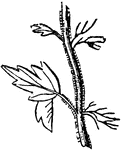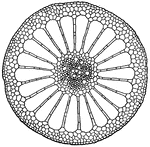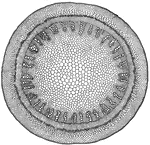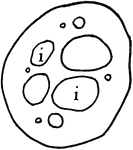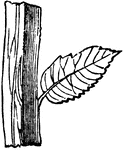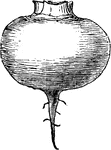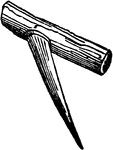The Stems and Roots ClipArt gallery provides 112 illustrations of the various types of stem and root structures in plants.
Tap Root
"When the root sinks perpendicularly into the earth, and tapers regularly from the base to the apex…
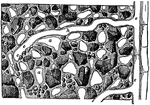
Roots in Soil
"Diagram to illustrate a root-hair (h) in the soil, and its relation to the soil-particles, the capillary…
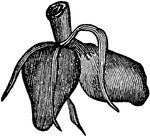
Didymous Roots
"Didymous roots are those which produce a tubercle each year, and when the tubercle of one year arrives…

Plant Skeletal Tissues
"Diagram showing the progressive development of the skeletal tissues from the apex toward the base of…
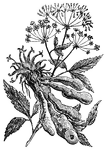
Skirret
Sium sisarum. "A species of water parsnip, generally said to be of Chinese origin, long cultivated in…

Seneca Snakeroot - Roots and Base of the Stem
"Polygala senega of eastern North America. It sends up several stems from hard knotty root-stocks, bearing…

Piece of Stem from a Soft Maple
Piece of a stem of Soft Maple, of a year old, cut crosswise and lengthwise.
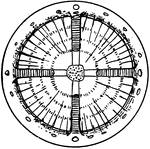
A. Capreolata Unusual Stem Growth
"Diagram showing some types of unusual growth in thickness. A, cross section through a four-year-old…
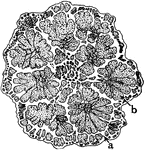
Bauhinia Unusual Stem Growth
"Diagram showing some types of unusual growth in thickness...B, cross section of stem of species of…
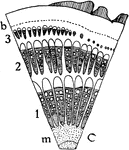
G. Scandens Unusual Stem Growth
"Diagram showing some types of unusual growth in thickness...C, portion of a cross section of stem of…
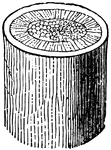
Stem of Flax
Short piece of stem of Flax, magnified, showing the bark, wood, and pith in a cross section.
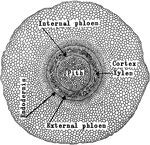
A. Pedaium Stem
"Adianium pedatum: transverse section of stem, showing the amphiphloic siphonostele." -Stevens, 1916

C. Viticella Stem
"Diagram showing the course of the vascular bundles in a stem of Clematis viticella. Median bundles…

Cerastium Stem
"B, diagram of vascular bundles in external view and in cross section of the stem of Cerastium. The…
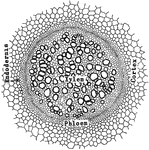
G. Pubescens Stem
"Gleichenia pubescens: transverse section of stem, showing the protostele." -Stevens, 1916

Ivy Stem
"Schizogenous resin duct in the young stem of ivy (Hedera helix), as seen in cross section. A, early,…
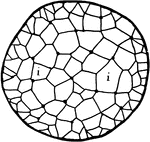
Juncus Stem
"A, cross section of stem of Juncus...the black lines traversing the section are really chains of cells…
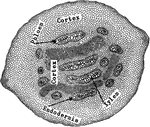
P. Aquilina Stem
"Pteris aquilina: transverse section of stem, showing the polystele." -Stevens, 1916
Palm Stem
"Cross section of a portion of palm stem. e, xylem; f, phloem portions of vascular bundle; g, sclerenchyma…

Palm Stem
"A, diagram of course of vascular bundles in a palm stem; 1m, 2m, 3m, bundles from the median portions…
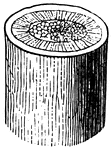
Woody Stem
The central part of the stem is the pith, then is the cellular tissue and finally the bark.
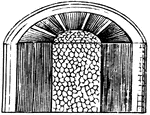
Woody Stem
The central part of the stem is the pith, then is the cellular tissue and finally the bark.

Sow Thistle - Stem with Heads, Basal Leaves, Flower, Achene with Pappus
"A plant of the genus Sonchus, primarily S. oleraceus, a weed of waste places, probably native in Europe…
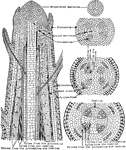
Plant Tissues
"Diagram showing the evolution of tissues from the primordial meristem down to the beginning of cambial…

Vascular Bundles
"Diagram showing how the vascular bundles anastomose around the medullary rays. The gaps represent the…
Water Flow in Pine
"Diagram indicating by arrows how the water in the tracheids of pine passes longitudinally from one…
Water Flow in Plants
"Diagram showing the relation of the water-carrying tissues of the leaves to those of the stem, and…

Water Hyacinth Roots
"Roots of the water-hyacinth (Eichornia crassipes Solms), showing removable root-caps; b, root-cap removed…



